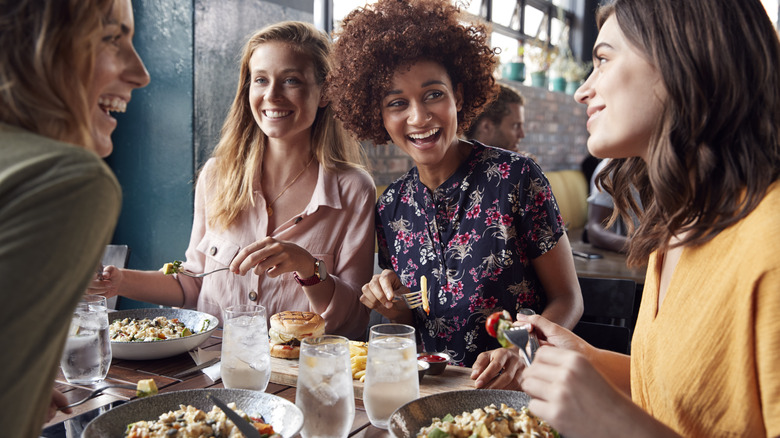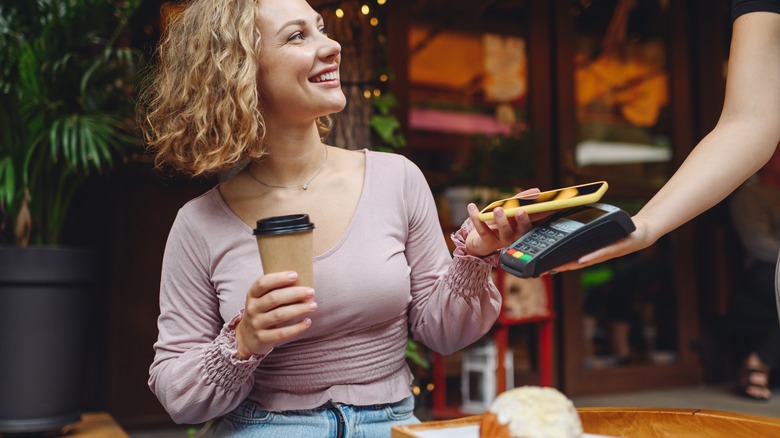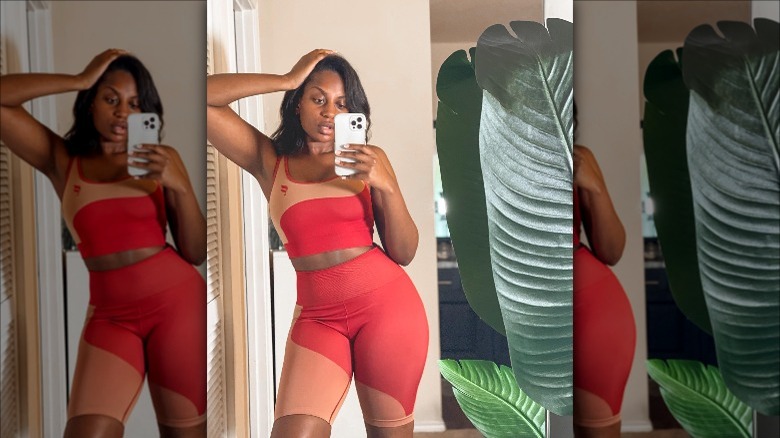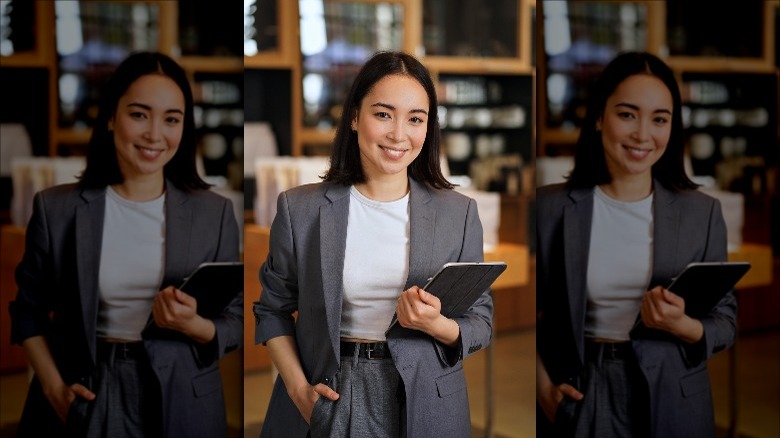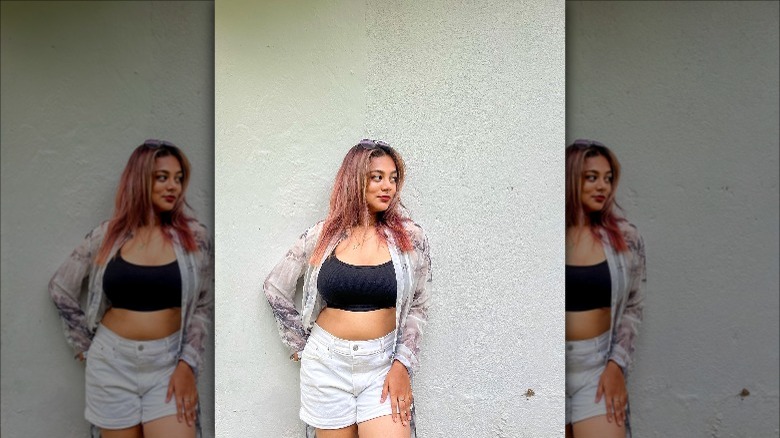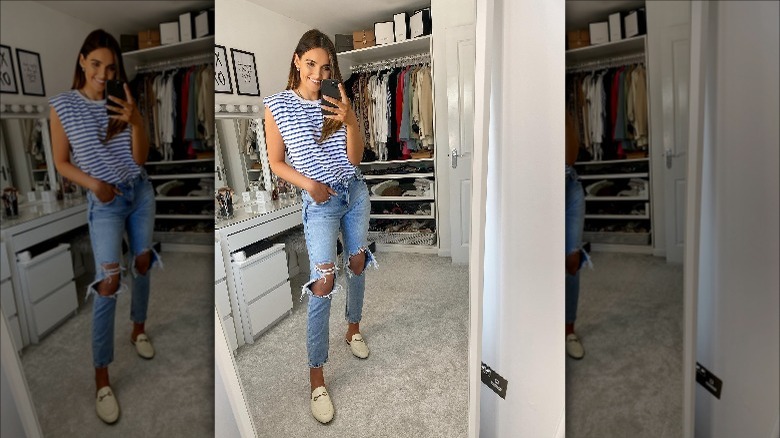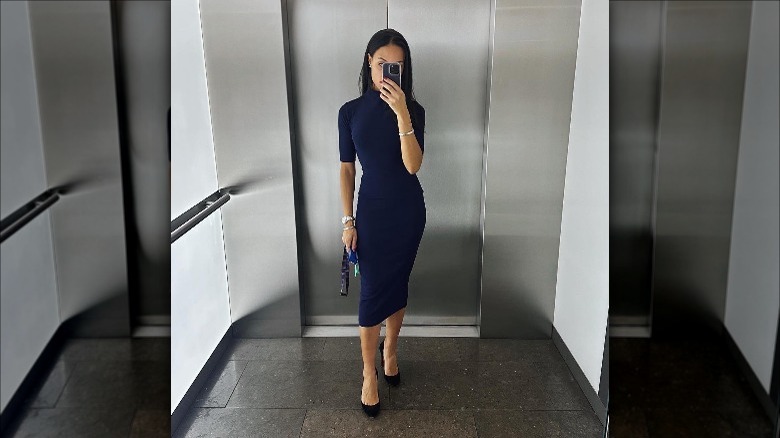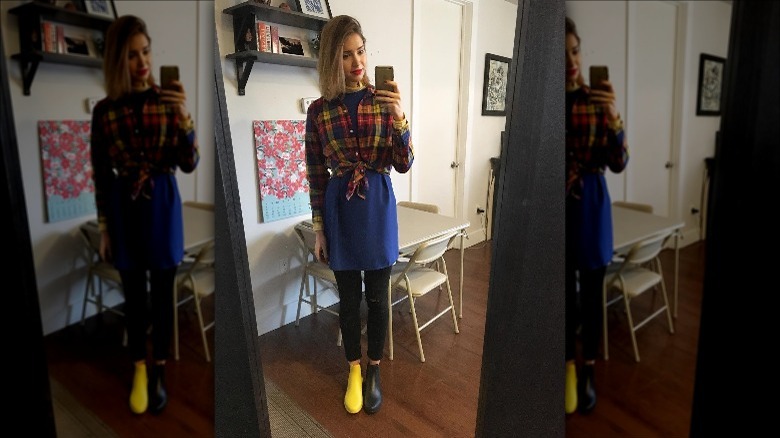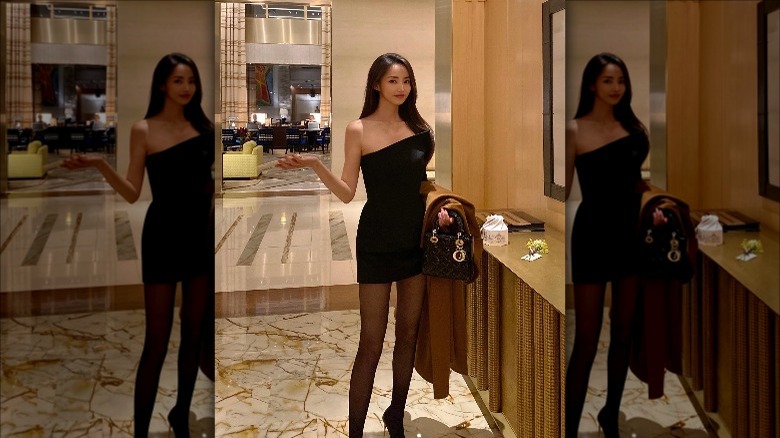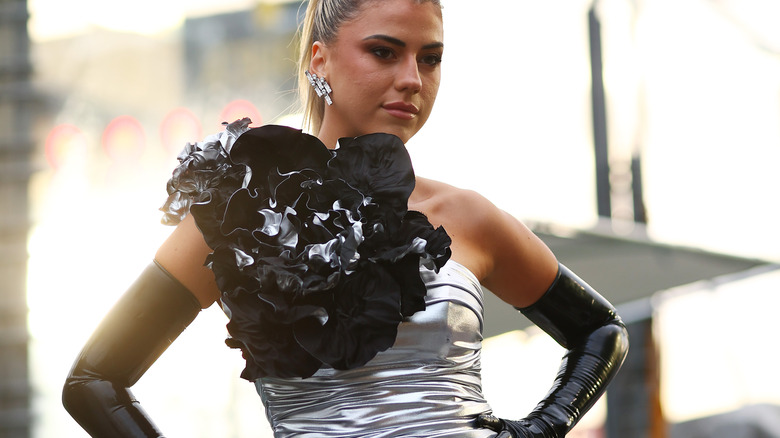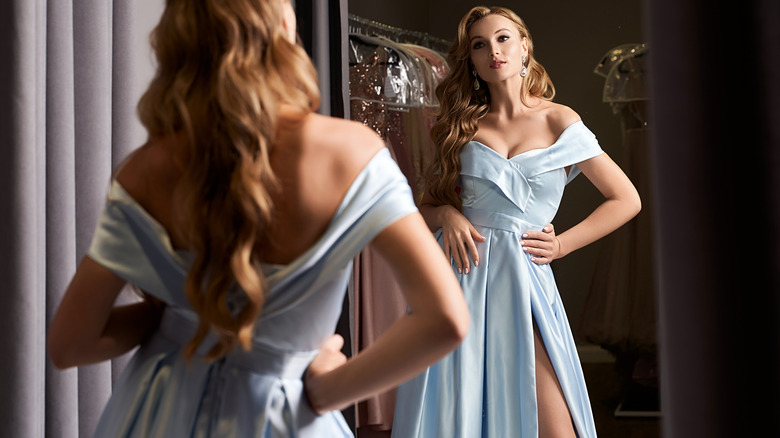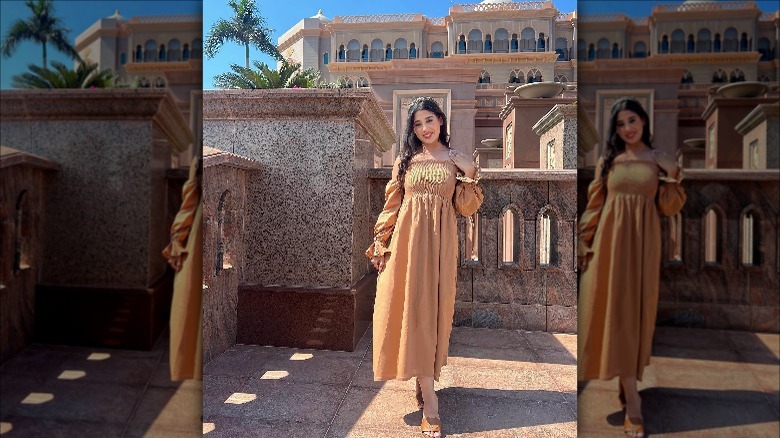The Ultimate Guide To Styling Yourself For Every Restaurant Dress Code
You don't necessarily have to be a die-hard foodie to see that we live in the golden age of going out to eat. From trendy, laidback taprooms to sumptuous, multi-star steakhouses, the sheer number of options can be mind-boggling. But the decision goes beyond the menu, ambiance, and cocktail list ... there's also the dress code to consider. Your eatery-of-choice's dress code can have a major impact on the experience you're looking for, be it a chance to show off that stunning new dress or simply a relaxing evening with great food and close friends.
According to reservation management site TableAgent, most dress codes fall into five general categories: casual, business casual, casual elegant, formal, and jacket required. That being said, those terms are hardly consistent across the industry; in many cases, there are multiple ways to describe the same basic dress code. And occasionally, you'll come across an establishment that uses its own unique terms to describe the expected attire for its guests, such as simple-and-chic or informally fabulous.
Even when you're dealing with a commonly-seen dress code, like elegant or smart casual, it can be difficult to know which pieces from your closet are going to fit the bill. Consider this your ultimate guide on what to do (and, perhaps more importantly, what not to do) when styling yourself for every restaurant dress code.
Casual: do aim for comfortable-yet-polished
The key to styling yourself for a dress code advertised as casual is to consider the restaurant's overall ambiance. After all, a fine-dining restaurant's definition of casual may very well be different from that of a family-friendly bar and grill. At its most informal definition, a casual dress code is all about comfort. Jeans, shorts, t-shirts, tank tops, and sandals are generally all acceptable. For most casual eateries, activewear is perfectly fine as well.
Restaurants that brand themselves as upscale-yet-casual or dressy casual can be a little trickier. The idea is still to remain comfortable but to add a level of polish that will make it seem as though you put more effort into your outfit than you actually did. Jeans are still on the table, but you might want to think twice about donning your coziest activewear or that t-shirt you throw on for quick trips to the store. A nice blouse, polo, or relaxed button-down are all great options to satisfy a casual dress code when you suspect that the restaurant's definition of casual is a bit more elevated than your average dive. Even opting for certain colors and fabrics can convey a sense of casual-yet-polished. Darker colors tend to be reserved for more formal settings, while materials like linen, canvas, and cotton practically radiate laidback summer vibes.
Casual: don't assume anything goes
While casual is the least demanding of all restaurant dress codes, that doesn't necessarily mean that anything goes, or even that it's impossible to make a faux pas. Some restaurants may have a more (or even a less) exacting definition of casual depending on factors such as overall atmosphere, location, or brand. For example, wearing a swim cover-up to lunch or dinner is going to be more acceptable at a beachside tavern than at a chic sidewalk bistro with a casual dress code.
If you're the type that abhors being over- or under-dressed for any occasion, or maybe you just want to play it safe, you might want to forgo some overly casual pieces like flip-flops, heavily distressed clothing, and even that super-comfy sweatpants-and-hoodie combo. If you know for sure that the restaurant has higher casual expectations than average, you'll likely want to bypass t-shirts, shorts, and tanks altogether in favor of a trendy shirt, blouse, fitted jeans, or even a sundress. Nevertheless, always remember that as casual as a dress code is intentionally vague, it's meant to be a little interpretive, so don't stress too hard over your attire.
Business casual: do take it up a notch
What's the difference between basic casual and business casual? The simplest way to convey this commonly-seen dress code is to ask yourself what you might wear in an office setting, even if your particular occupation doesn't involve an office. But unlike straightforward business wear, business casual involves a little more wiggle room for personal style and preference. It can still be difficult to determine what's appropriate and what isn't, though, as casual is still a relatively vague term. That's why many job search sites and tools, like Indeed, offer extensive descriptions of what qualifies as business casual.
The ultimate goal in meeting this dress code is to be comfortable yet professional. Your appearance should be relaxed but still pulled together. Slacks, khakis, and pencil skirts paired with a nice blouse, button-down, or sweater are all trustworthy options. Optimal shoes and accessories include loafers, mules, chic flats, scarves, belts, and simple jewelry. If you're still in a bit of a quandary over what to wear, it may be time to embrace a tried-and-true office wear staple: the blazer. Blazers are a simple wardrobe addition capable of adding instant professionalism to any outfit. They're especially good at elevating a business casual 'fit that is leaning heavily on casual.
Business casual: don't stray too far from officewear
As for what not to wear in a business casual setting, the key word to remember here is business. Even if you're having doubts about a certain piece's appropriateness, all is not lost. There is a huge variety of businesses across an equally large number of industries, so what's business-appropriate for one person may be different from what is suitable in another setting. A good rule of thumb is to imagine what you would wear if you were taking a client or customer out to lunch and go from there.
That being said, there are definitely some items that rarely, if ever, meet the business casual dress code. Flip-flops, shorts, crop tops, t-shirts, tanks, and other truly casual pieces are best left out of the picture. Athletic wear, including athletic shoes, is out of the picture, as well. And of course, the whole idea behind restaurant dress codes is to allow guests to be a part of the professional, casually upscale atmosphere of the restaurant itself. Stained, wrinkled, and unlaundered clothing is not acceptable, as are pieces that have clearly been worn well past their prime. As insanely comfortable as those heels you've had for a decade may be, they will need to pass on eventually, and maybe splurge on some cute replacements.
Smart casual: do dress for your brand
Yet another cousin of everyone's favorite laidback dress code (you know you secretly love showing up to dinner sans full hair and makeup), smart casual differs slightly, but distinctly, from basic casual and even business casual. The key here, or should we say the fun part, is that smart casual allows for more personal style choices and puts an emphasis on chic and trendy outfits and wardrobe pieces. A restaurant with a smart casual dress code is inviting you to be your most fashionable self, while still allowing for comfort. What's not to love?
Just keep in mind that this is a chance to showcase not only your impeccable sense of personal style but to provide any potential clients or customers who may join you at lunch with a visual representation of your brand. That means that you'll still want to keep things professional — you just have a bit more creative freedom. Reliable options to meet a smart casual dress code include blazers and jackets, trendy dresses and skirts, trousers and khakis, stylish blouses, button-downs, and collared shirts, as well as dress shoes, heels, boots, and slightly showier jewelry or scarves. Some restaurants aiming to get a similar look from their guests may prefer to advertise their dress code as casual elegant, which simply puts the option of more formal pieces on the table.
Smart casual: don't forget to be professional
A smart casual dress code certainly allows for more touches of personal style and can be a fun alternative to plain casual or business casual codes. However, it's important to remember that there is still an element of professionalism involved in smart casual, and it's definitely possible (sometimes even easy) to be too casual in this category. While dressier dark wash jeans are an option, you'll want to avoid falling into the trap of just throwing on a business-y blouse or blazer with some jeans and expecting it to magically transform into the perfect smart casual 'fit. Playing with material, texture, color, and cut are better and subtler ways to test the bounds of this dress code.
You'll want to forgo athletic wear, distressed denim, shorts, and anything that isn't up to the highest standards of neat, clean, and tidy. While dresses are more than acceptable, overly casual pieces are probably best reserved for the beach. Accessories such as hats, scarves, and statement jewelry are great ways to spice up a smart casual outfit that still needs a little bit of you in the mix. Just don't go overboard and end up with an unintentionally gaudy appearance–that wouldn't look especially smart.
Business: do take a step toward formal
While comfort does have its place in businesswear, you're not likely to find too many casual pieces amidst this dress code. Occasionally, you'll find a restaurant that narrows down the terms even further, asking guests to dress business professional or business formal. The major difference is the addition of more formal pieces for the latter category, while the former skews more towards dressy officewear. If you're desperate for some inspiration, it's difficult to beat Rachel Zane's (aka, Meghan Markle's) on-point style sense in "Suits." You're looking for an outfit that is polished, professional, and well ... down to business.
Dresses and suits (with the jacket) are business wardrobe staples, and you can't go wrong opting for such a piece if the restaurant demands any form of dressy business attire. Bonus points if any of those pieces are tailored (or simply look tailored) specifically to your body. Slacks, ties, and pencil skirts are also acceptable options, as are heels, dressy flats, some loafers, and other dress shoes. Keep jewelry and other accessories simple and chic. In the case of business formal, there is a very fine line separating it from all-out formal, or even semi-formal for that matter. In this case, you can wear more formal pieces, but remember to tone them down slightly by wearing less flashy accessories or wearing timeless style pieces such as trendy clutches or a pair of nude pumps.
Business: don't over-complicate your outfit
When compared to some of the previous dress codes on our list, business attire can seem like one of the more difficult to master. If you don't happen to be a name-taking Rachel Zane-esque attorney-slash-style icon, you might find that you have fewer wardrobe pieces to work with than if you were styling yourself for a smart casual lunch meeting with your boss. Even so, one of the easiest faux pas to commit within this dress code is to over-complicate your outfit. Business attire is typically going to be reserved, professional, and orderly. If your personal sense of style is a little more outgoing, it can be difficult to strike the right tone.
Some of our don'ts go without saying. Don't wear pieces that expose the midriff or too much cleavage. Jeans, shorts, mini-dresses, and anything that could count towards athletic wear are to be avoided in this dress code. Limit yourself to one flashy piece or accessory per outfit. The rest of your ensemble should be classic and understated. Don't go overboard on accessories in general: Too many accessories can give your 'fit a cluttered appearance, which is the exact opposite of what business attire should convey.
Semi-formal: do break out the LBD (little black dress)
Like business formal, a semi-formal dress code falls somewhere in between true formal and officewear. The difference is that semi-formal tends to be less concerned with looking professional, and leans more towards expressions of personal style with an upscale flair. You'll find quite a few restaurants with this dress code that want to convey a high-end experience without intimidating their guests with an overtly formal code. This makes a semi-formal restaurant the perfect place to break out that little black dress that never fails to slay.
Dresses and suits are the way to go for most semi-formal settings, though skirts and jumpsuits are more than acceptable, as well. Darker colors tend to give a more formal appearance overall, while lighter or brighter colors can add a certain pop and be a fun way to shake up your typical semi-formal wardrobe. In other words, consider a little red dress, or whatever color you're especially fond of. Above all, make sure that your clothes fit you properly, even if that means making a trip to the tailor. Loose, baggy, or otherwise ill-fitting clothes are not this dress code's friends.
Semi-formal: don't go over the top
While a semi-formal dress code is definitely an invitation to dress up and look your best, it is not necessarily the occasion to dress entirely to the nines. There is a difference between semi-formal and true formal. If formal wear is to be considered going all-out, semi-formal is one notch below that. Think of it as simply bordering on cocktail wear. It's still very possible to find yourself over-dressed, so, where should you draw the line and what should you avoid to meet a semi-formal dress code?
Naturally, denim and sneakers are to be avoided at all costs for this dress code. Furthermore, evening gowns and tuxedos — while they are definitely more appropriate than jeans — are a bit much for a semi-formal setting. Jewelry and other accessories, while allowed to be flashier than in a business setting, shouldn't be the entire outfit. If you're still in a quandary over what to wear, it might be worth it to consider dressing a certain wardrobe piece up or down to fit the occasion. This can easily be done by playing with metals, materials, wraps, and other adaptable accessories.
Formal: do take the chance to show off
Though formal restaurant dress codes are a bit rarer than some of the others on our list, they're also the codes with the least amount of wiggle room. But don't let that intimidate you! This is your chance to dress all the way to the nines. If it helps, pretend that you've been invited to the Met Gala. Take the opportunity to show off and wear the dress or tux of your dreams. But keep in mind that there are technically two categories of formal: black-tie and white-tie. White tie is the upper limit of formal, typically requiring a tux, white tie, and vest or long evening gown. That being said, restaurants requiring white-tie attire are few and far between. More often than not, you're going to be faced with a black-tie setting.
Tuxedos, dark suits, evening or ball gowns, cocktail dresses, and elegant evening separates are all appropriate choices for black tie. This is your opportunity to wear your very best pieces. Even if you're on a budget and can't afford a one-off shopping trip to buy everything you ever dreamed of wearing on such an occasion, never underestimate the power of the right accessories. Be it a chic pair of heels or a dazzling necklace that may or may not be cubic zirconia, it's surprisingly easy to bring the right business or semi-formal dress up a notch into formal territory.
Formal: don't lapse into casual territory
While the idea of a formal dress code is relatively easy to grasp, it's a little trickier to know if you're committing a faux pas. After all, what truly is the difference between a cocktail dress and an evening gown? The key to styling yourself properly for a formal dress code is fairly simple: If you're afraid that a piece you're considering wearing might be too casual, it's always best to err on the side of caution and assume that it is. After all, it's all but impossible to overdress in a formal setting.
Stay far away from denim, athletic wear, sundresses, office-appropriate pantsuits, wild prints, or anything that you might wear to a club. The idea is to maintain an appearance of elegance. Fit is also a critical element of formal attire–your clothes should be tailored (or at the very least, fit like a glove), properly laundered, and as wrinkle-free as the material will allow.
